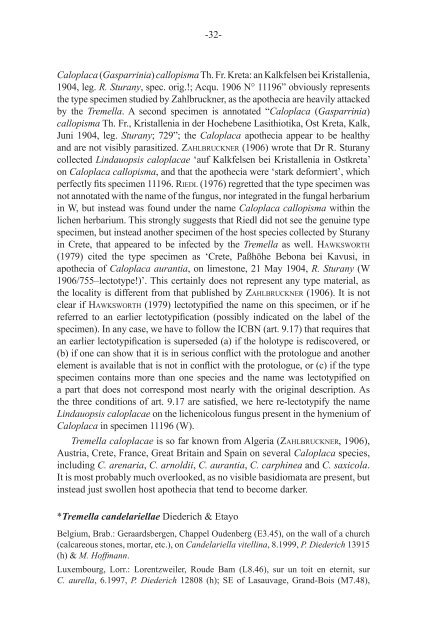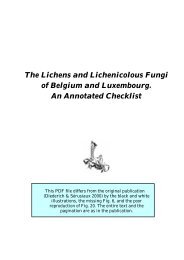LEJEUNIA - Lichens of Belgium, Luxembourg and northern France
LEJEUNIA - Lichens of Belgium, Luxembourg and northern France
LEJEUNIA - Lichens of Belgium, Luxembourg and northern France
You also want an ePaper? Increase the reach of your titles
YUMPU automatically turns print PDFs into web optimized ePapers that Google loves.
-32-<br />
Caloplaca (Gasparrinia) callopisma Th. Fr. Kreta: an Kalkfelsen bei Kristallenia,<br />
1904, leg. R. Sturany, spec. orig.!; Acqu. 1906 N° 11196” obviously represents<br />
the type specimen studied by Zahlbruckner, as the apothecia are heavily attacked<br />
by the Tremella. A second specimen is annotated “Caloplaca (Gasparrinia)<br />
callopisma Th. Fr., Kristallenia in der Hochebene Lasithiotika, Ost Kreta, Kalk,<br />
Juni 1904, leg. Sturany; 729”; the Caloplaca apothecia appear to be healthy<br />
<strong>and</strong> are not visibly parasitized. ZAHLBRUCKNER (1906) wrote that Dr R. Sturany<br />
collected Lindauopsis caloplacae ‘auf Kalkfelsen bei Kristallenia in Ostkreta’<br />
on Caloplaca callopisma, <strong>and</strong> that the apothecia were ‘stark deformiert’, which<br />
perfectly fits specimen 11196. RIEDL (1976) regretted that the type specimen was<br />
not annotated with the name <strong>of</strong> the fungus, nor integrated in the fungal herbarium<br />
in W, but instead was found under the name Caloplaca callopisma within the<br />
lichen herbarium. This strongly suggests that Riedl did not see the genuine type<br />
specimen, but instead another specimen <strong>of</strong> the host species collected by Sturany<br />
in Crete, that appeared to be infected by the Tremella as well. HAWKSWORTH<br />
(1979) cited the type specimen as ‘Crete, Paßhöhe Bebona bei Kavusi, in<br />
apothecia <strong>of</strong> Caloplaca aurantia, on limestone, 21 May 1904, R. Sturany (W<br />
1906/755–lectotype!)’. This certainly does not represent any type material, as<br />
the locality is different from that published by ZAHLBRUCKNER (1906). It is not<br />
clear if HAWKSWORTH (1979) lectotypified the name on this specimen, or if he<br />
referred to an earlier lectotypification (possibly indicated on the label <strong>of</strong> the<br />
specimen). In any case, we have to follow the ICBN (art. 9.17) that requires that<br />
an earlier lectotypification is superseded (a) if the holotype is rediscovered, or<br />
(b) if one can show that it is in serious conflict with the protologue <strong>and</strong> another<br />
element is available that is not in conflict with the protologue, or (c) if the type<br />
specimen contains more than one species <strong>and</strong> the name was lectotypified on<br />
a part that does not correspond most nearly with the original description. As<br />
the three conditions <strong>of</strong> art. 9.17 are satisfied, we here re-lectotypify the name<br />
Lindauopsis caloplacae on the lichenicolous fungus present in the hymenium <strong>of</strong><br />
Caloplaca in specimen 11196 (W).<br />
Tremella caloplacae is so far known from Algeria (ZAHLBRUCKNER, 1906),<br />
Austria, Crete, <strong>France</strong>, Great Britain <strong>and</strong> Spain on several Caloplaca species,<br />
including C. arenaria, C. arnoldii, C. aurantia, C. carphinea <strong>and</strong> C. saxicola.<br />
It is most probably much overlooked, as no visible basidiomata are present, but<br />
instead just swollen host apothecia that tend to become darker.<br />
*Tremella c<strong>and</strong>elariellae Diederich & Etayo<br />
<strong>Belgium</strong>, Brab.: Geraardsbergen, Chappel Oudenberg (E3.45), on the wall <strong>of</strong> a church<br />
(calcareous stones, mortar, etc.), on C<strong>and</strong>elariella vitellina, 8.1999, P. Diederich 13915<br />
(h) & M. H<strong>of</strong>fmann.<br />
<strong>Luxembourg</strong>, Lorr.: Lorentzweiler, Roude Bam (L8.46), sur un toit en eternit, sur<br />
C. aurella, 6.1997, P. Diederich 12808 (h); SE <strong>of</strong> Lasauvage, Gr<strong>and</strong>-Bois (M7.48),





